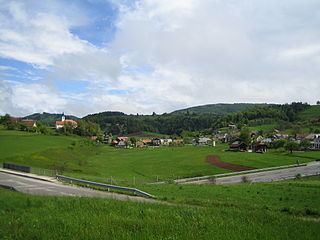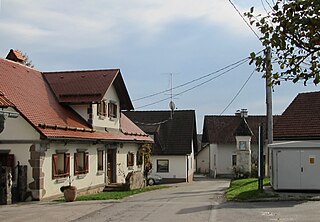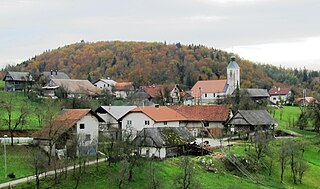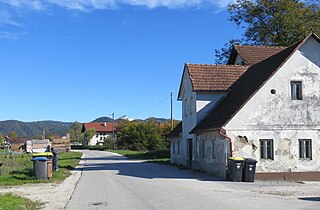
Trboje is a village in the Municipality of Šenčur in the Upper Carniola region of Slovenia. It lies east of Lake Trboje.

Planina nad Horjulom is a dispersed settlement northwest of Horjul in the Municipality of Dobrova–Polhov Gradec in the Upper Carniola region of Slovenia. It includes the hamlets of Kolobocija, Lom, Pustota, and Zameja, as well as part of the hamlet of Suhi Dol.

Selo nad Polhovim Gradcem is a dispersed settlement in the hills above Polhov Gradec in the Municipality of Dobrova–Polhov Gradec in the Upper Carniola region of Slovenia. It lies between the Petač Gorge with Big Božna Creek to the south and the Hrastnica Valley to the north. It is on a formerly important freight route between Škofja Loka and Polhov Gradec.

Šentjošt nad Horjulom is a settlement in the Municipality of Dobrova–Polhov Gradec in the Upper Carniola region of Slovenia. In addition to the main settlement, it also includes the hamlets of Kogel, Krvinet, Kurja Vas, Paradiže, Pišek, Potok, and Stavnik, as well as part of the hamlet of Suhi Dol.

Rodica is a settlement on the outskirts of Domžale in the Upper Carniola region of Slovenia. It includes the hamlet of Groblje.

Črni Vrh is a settlement in the hills south of Idrija in the traditional Inner Carniola region of Slovenia. It includes the hamlets of Zgornja Vas, Spodnja Vas, Trate, Trebče, and Zidiše.

Begunje pri Cerknici is a settlement north of Cerknica in the Inner Carniola region of Slovenia.

Mlaka pri Kočevju is a settlement north of the town of Kočevje in southern Slovenia. The area is part of the traditional region of Lower Carniola and is now included in the Southeast Slovenia Statistical Region.

Selo pri Robu is a settlement on the Rute Plateau in the hills southwest of Rob in the Municipality of Velike Lašče in central Slovenia. The municipality is part of the traditional region of Lower Carniola and is now included in the Central Slovenia Statistical Region.

Šentpavel is a settlement in the hills southeast of the capital Ljubljana in central Slovenia. It belongs to the City Municipality of Ljubljana. It is part of the traditional region of Lower Carniola and is now included with the rest of the municipality in the Central Slovenia Statistical Region.

Dravlje is a former village in the City Municipality of Ljubljana, the capital of Slovenia.
Kočno ob Ložnici is a village on the right bank of the Ložnica River in the Municipality of Slovenska Bistrica in northeastern Slovenia. The area is part of the traditional region of Styria. It is now included with the rest of the municipality in the Drava Statistical Region.

Brezovica pri Črmošnjicah is a small settlement in the Municipality of Semič in Slovenia. The area is part of the historical region of Lower Carniola. The municipality is now included in the Southeast Slovenia Statistical Region.

Polica is a settlement in the Municipality of Grosuplje in central Slovenia. The area is part of the historical region of Lower Carniola. The municipality is now included in the Central Slovenia Statistical Region.

Zgornja Slivnica is a settlement in the Municipality of Grosuplje in central Slovenia. It lies in the hills north of Grosuplje and northeast of Šmarje-Sap and south of Mali Lipoglav in the historical region of Lower Carniola. The municipality is now part of the Central Slovenia Statistical Region.

Troščine is a small village north of Polica in the Municipality of Grosuplje in central Slovenia. The area is part of the historical region of Lower Carniola. The municipality is now included in the Central Slovenia Statistical Region.

Polje pri Višnji Gori is a settlement southeast of Višnja Gora in the traditional region of Lower Carniola in central Slovenia. It belongs to the Municipality of Ivančna Gorica, which is included in the Central Slovenia Statistical Region.

Dobrunje is a formerly independent settlement in the southeast part of the capital Ljubljana in central Slovenia. It belongs to the City Municipality of Ljubljana. It is part of the traditional region of Lower Carniola and is now included with the rest of the municipality in the Central Slovenia Statistical Region. In addition to the main settlement, Dobrunje consists of the hamlets of Devce, Marinki, Na Trdnjavi, Ob Cesti, and Pod Ježo. Rastučnik Creek, which begins below Orle, runs through the western part of the settlement before joining the Ljubljanica.

Zavoglje is a formerly independent settlement in the eastern part of the capital Ljubljana in central Slovenia. It lies at the confluence of the Ljubljanica River with Dobrunjščica Creek. It is part of the traditional region of Lower Carniola and is now included with the rest of the municipality in the Central Slovenia Statistical Region. In addition to the main settlement, Zavoglje includes the hamlet of Mrakovce.

Štepanja Vas is a formerly independent settlement in the southeast part of the capital Ljubljana in central Slovenia. It belongs to the City Municipality of Ljubljana. It is part of the traditional region of Lower Carniola and is now included with the rest of the municipality in the Central Slovenia Statistical Region.





















